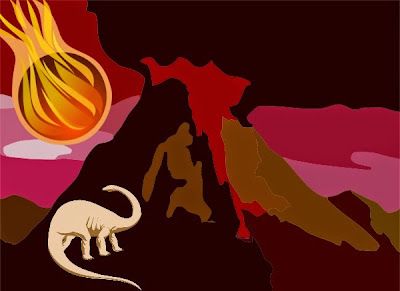Asteroids, Volcanoes, and Dinosaur Demise
Secularists really have no idea what caused dinosaur extinction, and that is a thunder lizard-sized reason their stories keep changing. The alleged Chicxulub asteroid impact down Mexico way is the dominant explanation, but not all scientists are in agreement on that. Perhaps it was volcanic activity. Mayhaps it was a combination.
There is an area in India known as the Deccan Traps that has significant lava flow layers. Geologists got a hankering to do some research, and tied this volcanic activity with the Chicxulub impact. Wait, what? There is quite a bit of distance between the two points of significant geological activity. If you take out the circular reasoning and fundamentally flawed presuppositions in radiometric dating, the relative timeframe can be useful. Bad news for old Earth advocates, though: the evidence actually supports creation science Flood geology models.
 |
| Image assembled from components at Clker clipart |
In its October 2nd, 2015 issue, Science published a report announcing a more detailed study of the many lava flows in the Deccan Traps located in Western India. The Deccan Traps are a massive igneous province—think of it as a lava flood plain—comparable in size to the US states of Oregon and Washington combined and composed of numerous lava flow layers having a total depth of over 6,500 feet (2,000 meters). The strategy was to examine the mineral composition of the lava flows from older samples on the bottom, to younger samples near the top of this thick sequence of lava flows. According to the report, the lava flows show differences in composition, and the timing of their eruption, according to the radiometric dating methods used, coincide remarkably well with the 66-million-year-old conventional date of the Chicxulub impact (within 50,000 years). The volcanic fissures in the area are interpreted to have been active before the impact, but with much smaller eruptive events. Lava flow rates appear to have markedly increased at roughly the same time as the asteroid impact.It would be right neighborly of you to read the entire article. To do this, click on "Asteroids Hit First, Volcanoes Deliver Knockout Punch to Dinosaurs?" You may also like "Dinosaur Extinction and Chicxulub Revisited".